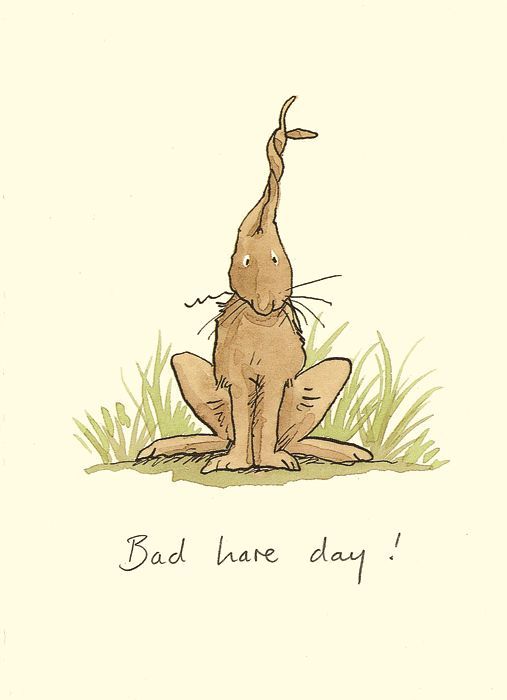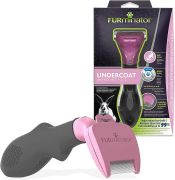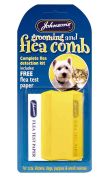The 5 Types of Rabbit Grooming - And How You Can Help
The 5 types of Rabbit Grooming - And How You Can Help!
When we think about grooming, we often think about making ourselves look tidy or looking pretty, but in rabbit world grooming is essential for wellbeing and health - and it’s a task that should be carried out daily.
But why is it so important? And how do you groom a reluctant bunny?? Read on to learn a little more on the different types of grooming, the ‘whys’ and the all-important ‘how’!!
Bad Hair Day?
Most of us have suffered with a bad hair day - just like the lovely Anita Jeram greetings card Bad Hare Day! Whilst a quick comb-through may ‘do’ for us humans, rabbits can spend a great deal of time daily grooming themselves, and their partners.
Grooming is an essential daily activity for rabbits to ensure they keep themselves in tip-top condition. And there are number of other other reasons that may be breed specific, or due to health constraints - and then there's the weather effect too.
Here's our take on the different types of grooming - how many different types of grooming from our list have your little ones demonstrated?
Just Grooming ... ?
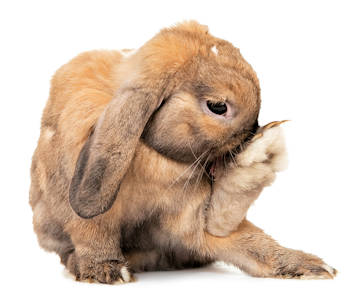
In rabbit world grooming is not ‘just grooming’.
There can be a number of reasons and issues surrounding grooming that rabbit owners should be aware of, and react to accordingly. So first, here’s a quick summary of some of the different types of grooming activities a rabbit can carry out.
Daily grooming - this daily activity is designed to remove normal loose fur and remove any dirt or debris - and to keep bunny looking fine!
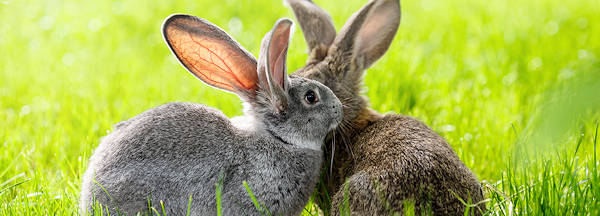
Rabbits socially groom their companions - sharing the love!
Social Grooming - this is usually carried out with their partner, and most owners will testify to the fact that there’s not many happier sights than watching two rabbits mutually groom each other 'ying and yang' style! This behaviour helps to cement the relationship and give/receive comfort - pretty much the bunny way of ‘sharing the love’. It’s a very comforting, relaxing activity, often seen prior to a nap! A rabbit can also groom their human ‘partner’ particularly when being stroked and again it is a sign of love and cementing the relationship.
Moulting grooming - an essential time for rabbits where the old fur being shed needs to be removed. This mostly occurs as the seasonal weather changes, but can also occur frequently throughout the year for indoor bunnies. A huge amount of fur needs to be removed during the moult, and this fur is mostly ingested. This can cause a strain on the digestive tract as fur is not easy to keep moving though the digestive system like hay and food is. Cat owners will be familiar with the feline method of dealing with this large amount of ingested fur, which involves the less than charming habit of them ‘hacking up a hairball’ to clear their digestive system of any excess hair, but rabbits are physically unable to vomit, so their ingested fur must go through the entire digestive system and out the other side in their poop. If too much fur is ingested at any one time, problems such as a slowed gut motion or even a potentially fatal blockage can arise, so grooming your rabbits during moulting is essential - the more loose fur you can remove yourself, the less they will be ingesting and the less chance they have of a fur block or digestive problem - both of which will involve a vet visit. It really is of paramount importance, and the longer the fur or the bigger the moult, the more critical this becomes. We typically find the biggest moult can be the winter/spring moult as a heavy winter coat to keep warm has often been grown which is then quickly shed at the onset of spring.
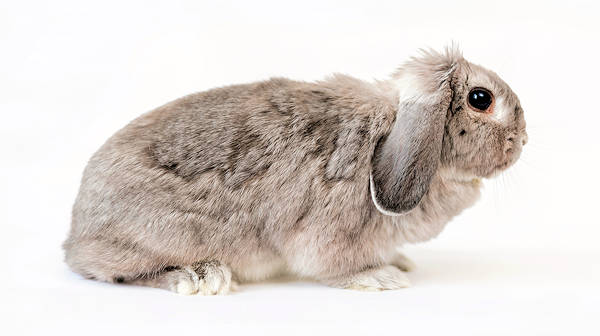
Rabbit showing moulting - definately a bad hair day!
Take a look at our Spring Healthy Tips blog for some important information on helping your rabbits deal with their fur moult - and this additional help involves ensuring your rabbit eats lots of hay and drinks lots of water. We’re here to help any reluctant hay eaters, so do get in touch if your rabbit needs to get the hay habit!
Stress Grooming - this can be caused by a number of issues - anxiety, stress, loss of a partner, boredom, infestation of fleas or mites etc, but nearly always shows as intense grooming in a localized area, often creating a bit of a bald patch that can get very sore or infected. This type of issue should be investigated with your vet to help identify and treat the underlying cause and to keep delicate bald skin protected whilst the issues are being addressed.
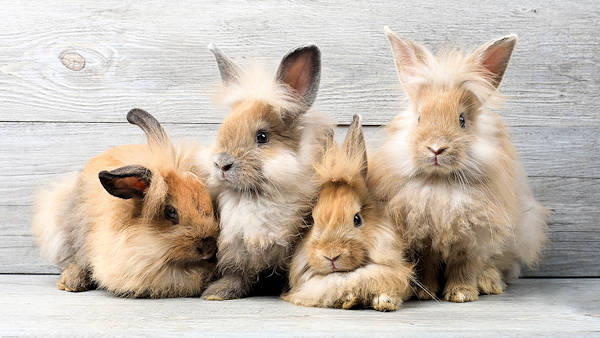
Some rabbits have more fur than others ...!
There’s also another category of grooming that involves a bit more intervention from us humans, and we call it assisted grooming. It is important for some breeds of rabbit such as angoras and lionheads, where the fur is either too long to be easily removed by the rabbit themselves or where because of illness or disability for example, the rabbit is unable to groom itself. And it’s worth noting that long haired rabbits will need extra assistance from us humans during the summer months to keep cool (often by a fur trim), and to keep from developing matted fur where knots get bigger and bigger - this can become extremely painful if left untreated and even tear a rabbits thin and delicate skin leading to infection or worse.
Our task, as rabbit owners is to help in the daily, moulting and assisted grooming, to help any stress-related grooming be investigated, treated or managed, and to enjoy and participate in the social grooming. A grooming session is also a great opportunity to give them a little health check, and make sure all is well. Bumps, scabs, long nails, sore hocks etc can all be identified during a grooming session, with problems quickly treated before they become an issue.
Helpful hints for happy grooming!
The word grooming often conjures up a picture of brushes and combs and clippers, but for rabbits, grooming is much more of a ‘thing’, as you can see from the number of different types of grooming rabbits carry out!
Unlike dogs, who often enjoy a bit of pampering, rabbits, as a prey species, generally do not enjoy being constrained, brushed, pampered or groomed by us humans. Plus younger rabbits have too much energy to sit still long enough for you to even get a brush out! So grooming, whilst obviously necessary at least once daily for a number of reasons, can become a thing … then a big thing … and then very quickly a nightmare if we’re not careful.
Longer term, the softly softly approach works best, and grooming doesn’t have to be a formal process or specific ‘grooming session’; it can be carried out whilst your bunny is snoozing on the floor using your fingers to stroke or tease out lose fur, for example. Using a fur removal glove can help here too. Nail length can be gently checked, ears stroked for signs of scabs or lose skin, tail lifted for a basic bum check, and even hind legs gently touched to help with trust if appropriate. That’s a fur removal and a basic bunny health check all carried out in a few minutes during a well earned bunny snooze!
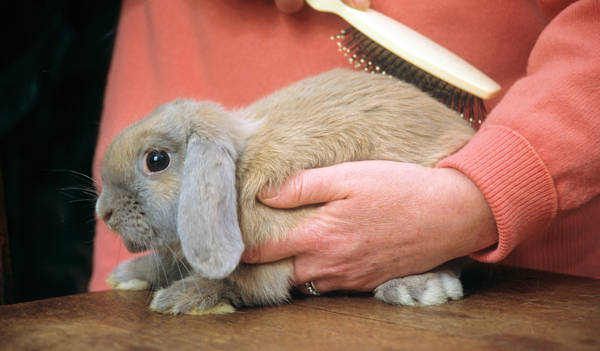
Ah, if only it could be that simple! But perhaps it could …?
Try hand feeding a few pellets - it’s amazing what can be done if there’s a tasty nugget of food or pellet about! Or even the holy grail of a fenugreek crunchie, perhaps?
What foods do your little ones go mad for? That’s your best grooming aid!! Just keep in mind moderation of course!
If your rabbit tends to take a snooze at a particular time of day, carry out a bit of advanced planning and have a comb, brush or glove handy so you can have a little spur of the moment grooming session when the opportunity arises!
We’d not recommend trying to cut toenails under these impromptu grooming sessions as a sudden movement may mean a cut in the wrong place - VERY ouchy! See our blog on nail clipping for help with this particular task!
If a little fur knot is discovered, it may not need removing there and then if your bunny is nervous (though it does have to be sorted asap!), teasing the knot a little over a few hours until it can be gently removed without your rabbit taking much notice may be more productive longer term in terms of trust than immediate constraint and removal, but it depends on the circumstances; you know your rabbit best - your job is to identify, assess and act appropriately - it really is tough being a bunny parent!
Be extremely careful not to cut the skin if you are trying to cut away a knot. If you can’t be 100% certain where knot ends and skin starts, cut only the top of the knot where you can be 100% certain, and then tease the know gently open - this may take a little time!
Never underestimate the effectiveness of a quick grooming session. A calm approach, soft touch, and taking time can go a long way to help a nervous bunny. And a suitable bunny treat can go a long way in ending a grooming session positively too, of course!
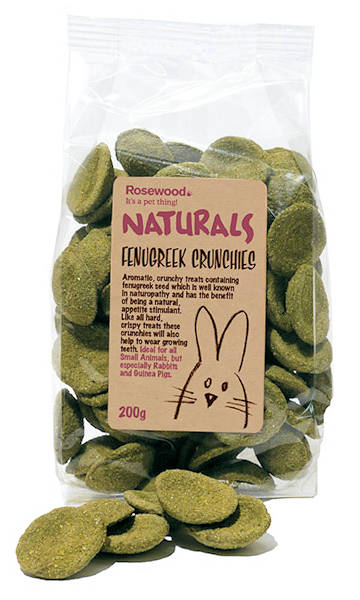 In all seriousness, it’s important for the success of the next grooming session for the current grooming session to be a positive experience. If you feel your rabbit is getting a bit stressed, stop what you’re doing when you’re able to and let them take a break. Distract with a toy or treat and start again once the stress has gone.
In all seriousness, it’s important for the success of the next grooming session for the current grooming session to be a positive experience. If you feel your rabbit is getting a bit stressed, stop what you’re doing when you’re able to and let them take a break. Distract with a toy or treat and start again once the stress has gone.
And if you have a new arrival, carry out these grooming sessions as early and as frequently as you can; they will hopefully quickly accept that these session are the ‘norm’ and nothing to be feared.
There are times when it is appropriate for us to take the control in a grooming session. Maybe this is because of knot that need removing or nails needing clipping, or perhaps there’s a spot of bunny bum cleaning to be done at the same time, or some medicine needs to be given or applied. In these instances, rabbit (and human!) safety comes first:
- If you’re able to carry this activity out at floor level, do so, as it removes the risk of a fall.
- An extra pair of hands if available, can help keep your rabbit still and safe
- Using a towel to wrap your rabbit ‘burrito style’ will help keep your rabbit safe and still - it is stressful, so should only be carried out when necessary - but it is a good technique to use when it is necessary.
- Ask your local veterinary practice if they have sessions to help with grooming or handling - this is often carried out by a nurse who may give some specific help with your rabbit and may help you become more confident with nail clipping, for example.
Trancing, the practice of laying a rabbit on its back to ‘trance’ and keep the rabbit immobile is not recommended. This body position is the rabbit ‘playing dead’, and studies have shown this position to be very stressful for the rabbit. Further information on this can be found on the rabbit welfare website at https://rabbitwelfare.co.uk/trancing/
The Right Tools for the Job
Find the grooming tools that work for your and your rabbits. There are different combs, brushes, nail clippers and fur removal aids, but each have different benefits and some trialling may need to be carried out to find what works for you and yours.
Here’s a quick summary some of the tools you may find useful during your grooming sessions:
- Soft bristle brushes - very good for short haired rabbits, but can be less effective on longer or matted fur. Due to their softness, they may be useful around the face (not eyes!)
- Narrow tooth combs - again, great for shorter haired rabbits, and also good to help with flea removal - see our flea comb and spot on treatment and repellents for for help with this too!
- Wide tooth combs - may be ineffective on short coats, but can be very good with longer fur or to help remove tangles.
- Coarse/hard bristle brushes - we recommend caution here as some hard bristle brushes may be scratchy on delicate rabbit skin. We recommend using only coarser brushes that have rounded bristle tips.
- Small Animal FURminator - specially made for small animals - can help remove lose undercoat fur.
- Nail clippers/guillotines - ensure you use clippers designed for pet claw nails only (not traditional scissors or human nail clippers as these will split/damage claws)
- Scissors - use to help clip away knots or matted fur. Use either rounded tipped grooming scissors or round-tipped baby/infant nail scissors which are often much shorter in length and easier to use safely.
- Blood-Stop Swabs or Trimmex StopBleed and tissue if you’re planning to cut nails. Just in case!
- A suitable treat or two!
We hope you find the above useful - and if you have a trick or grooming tool that works for you we’ve not mentioned do let us know and we’ll share in case it helps others!


